IV.Coalition of the unwilling
With the 1918 twin reform of universal suffrage and proportionate
representation the christian coalition conquered the power in the state for a long
time. From 1918 to 1967 the christian parties had an absolute majority in government.
Still, using this majority was a different question. Catholics and protestants
had been united by their desire to solve the school struggle. The pacification
of 1917 had given them exactly what they wanted, and it turned out that there was
little else that kept them together, except for a vague desire for “christian
politics” and the exigencies of remaining in power.
Besides, the relation between catholics and protestants began to shift. Where up
until 1918 the ARP had been the undisputed leader of the christian coalition, with
the catholics cast in the role of supporting act, the 1917 reforms required the
catholics to change their game in order to keep their left wing happy.
In the end this led to an increasing friction between catholics and protestants,
while at the same time they were forced to rule the country together.
The catholic denomination
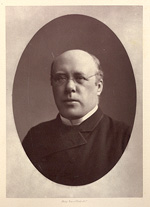
Herman Schaepman (1844-1903), catholic priest, writer and politician, de facto
RKK leader 1888-1903.
Schaepman was by far the most intelligent and active of the catholic MPs, and although he was well to the left of
most of his fellow catholics on social issues, he still functioned as their effective leader.
Like Kuyper, Schaepman was against the French Revolution and all that it stood for. For that reason he applauded
the creation of the ARP as well as the Antithesis and supported all catholic/protestant governments to the hilt.
Schaepman was an ultramontanist who put the papal power above any merely temporal power, and whose catholic
faith formed the inspiration of both his political and his (unfortunately rather old-fashioned and bombastic) work as a poet and writer.
Catholics formed about 99% of the population of the two southern provinces, and about
25% of the population of the northern ones. They have always been the most regionally
segregated denomination.
One effect of this extreme concentration was that, although catholics didn’t even have to try
hard to conquer all southern districts, they had a tough time of converting their northern
votes to seats, and were mostly relegated to supporting anti-revolutionary or christian-historian
candidates.
Obviously, it was the church that organised the catholic denomination, including its
political component. Bishops, priests, and monks all exhorted the faithful to keep loyal
to the catholic organisations, and to vote catholic come the elections, despite any differences
they might have. Ecclesiastical sanctions were occasionally used; most famously in 1954,
when the bishops forbade catholics to be a member of any socialist organisation.
It was only with the advent of proportional representation that the catholics truly
started to develop political muscle.
When the monolithic southern voting block was combined with the many pockets of catholicism in the
northern provinces, the catholic parties gathered about one third of the national vote. In
order to get that share of the vote up, more catholics were needed.
Thus the catholic church insisted on large families; in the Netherlands maybe even more than in other
countries. If the catholic denomination grew at a faster rate than the other three, the catholic
party would become more and more powerful. Catholic demographers eagerly calcuated the
tipping point when catholics would constitute more than 50% of the Dutch population
and the catholic party would hold an absolute majority in parliament.
Emancipation
In 1853 the Pope restored the Dutch episcopal hierarchy in a unilateral action. The protestants reacted by a wave of
demonstrations against the godless papists, but instead of retreating into their own world, the catholics
replied by becoming proud of their faith and considering themselves equal to the hitherto-dominant protestants.
They eagerly supported the Holy Father in his struggle against the secular, liberal Italian
state, and sent off thousands of young men to serve in the papal armies.
In parliament
it took the catholics a long time to find their own voice, and until 1918
they fulfilled the role of reliable allies, first of the liberals, then of the protestants.
The alliance with the ARP brought the catholics into government on a regular basis. Nonetheless, in this
phase the ARP was dominant, and the catholics mostly followed the anti-revolutionaries, despite
having more seats in parliament.
Part of the reason was that catholics were still not quite the equals of protestants, decades
of emancipation notwithstanding. Another was that until 1918 most catholic
politicians were pretty reactionary, and were mostly interested in keeping things in the
south as they had always been. The anti-revolutionaries were quite willing to grant
the south to the catholics, provided they got the north, as well as the overall guidance
of the christian coalition.
Parties
Despite having a highly organised church (or maybe exactly because of it), the
catholics were slow in creating a formal party. Until 1926 the catholics were a
loosely joined group that usually voted as a block in parliament, but did not
see the need for the creation of a formal party.
In 1926 the fateful step was taken and the RKSP (Rooms-Katholieke Staatspartij;
Roman Catholic State Party) was founded. This changed very little in catholic
politics. In 1944 the party was renamed to KVP (Katholieke Volkspartij; Catholic
Popular Party), and the biggest difference was that the KVP was more serious about
cooperating with the social-democrats than the RKSP. Still, the cooperation had
started in the RKSP era. Continuity remained more important than change in
the catholic world.
Uniquely among the denominations, the catholics had only a single party. A major
taks of the church was to make sure that dissenters and critics remained within
the RKSP or KVP, and that the few catholic fringe parties that did make it to
elections remained small, and were heavy-handedly returned to the flock as soon
as possible.
Therefore, non-standard catholic parties have conquered a grand total of six
seats in the entirety of Dutch parliamentary history. Two of those were for left-wing
RKVP before the war (one in 1925, one in 1933), the right-wing KNP entered parliament
in 1948 with one seat, then doubled to two in 1952, and at the tail end right-wing
RKPN conquered one seat in 1972.
Thus, in addition to being the largest, the catholic denomination was also
the best-organised. And that leads to power. Lots and lots of power.
The southern one-party state
It’s best to see the two southern provinces as
one-party states dominated by the RKSP, later the KVP, which habitually got about 80 to 90% of the vote.
The party was so overwhelmingly powerful that it often didn’t bother to run candidates in local
elections; instead, several local groups (who of course all agreed with the basic catholic tenets) were allowed
to run local politics, as long as they delivered catholic voters in the national elections. It wasn’t
much fun to be the lone liberal or socialist in these town councils.
Curiously, even though RKSP and KVP were totally dependent on the southern block, most of the
party leaders came from the catholic pockets in the north.
The south had lacked an intelligentsia for long, and those few that were available were mostly
protestant or liberal. Thus, the northerners took command of the southern block.
Still, the catholics’ electoral stranglehold on the south depended on their ability to
keep both left-wingers and right-wingers on board. In practice it was the left-wingers that caused
the party most trouble, and a large part of Dutch politics until the 1970s revolves around
the catholic left.
Left and right
Just like the liberal and protestant ones, the catholic denomination contained many different viewpoints. The
southern industrial capitalist and his workers were all catholic, but they had sharply different
ideas about social issues.
Where liberals and protestants eventually solved the left/right problem by splitting up into several
parties, this option was not available for the catholics, who were determined to form one single group
in which the catholic faith was more important than merely material issues.
Initially the right wing was dominant.
The average catholic MP was conservative, even reactionary, and opposed to anything that
smacked of new stuff. The only exceptions to this rule, curiously, were catholic leaders
Schaepman and Nolens, who had an open eye for the problems of poor catholics.
This changed in 1918, when proportional representation was introduced. Sure, this reform
helped the catholics, since the votes of the catholics in protestant-majority
regions also started to count for the total number of catholic seats. The flip side of the
coin was that left-wing catholics, even in the south, could now easily vote for another party.
Party leadership had to operate very carefully and present plans and ideas that would
suit both the working-class left wing and the upper-class right wing. Thus, the catholics, more
than any other denomination, are the inventors of the typically Dutch bland centrist soup, in
which compromises dilute both the left and the right standpoint until nobody was happy but everybody
could agree to go on together.
Still, in the Interbellum the bishops were adamantly opposed to catholic cooperation with
the socialists. That changed in the very last months before World War II, and after the war
the catholic/socialist cooperation started up in seriousness. The point of this cooperation
remained to keep the catholic left wing on board.
The socialist denomination
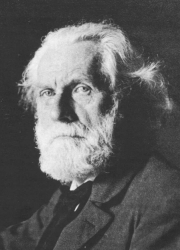
Ferdinand Domela Nieuwenhuis (1846-1919), SDB party leader 1881-1894.
Originally a lutheran minister, Domela
quit his job to edit the first socialist newspaper, and became founder and leader of the SDB (Sociaal-democratische Bond;
Social Democratic League). He financed the nascent movement mostly by spending his inheritance.
In 1888 he was elected to parliament, but his tenure was not a success, and he decided not to re-run in the 1891 elections.
Afterwards Domela moved to outright anarchism, denying that the oppressed had anything to expect from the state,
even one with a strong socialist party.
In 1894 the SDAP split from the SDB, and for the rest of his life Domela waged a bitter struggle against Troelstra
and his parliamentary strategy.
By the time he died he had become something of an icon for the socialists despite his unrelenting criticism of
the social-democratic wing.
Who were these socialists that the catholics were so afraid of?
For a Western European country, the Netherlands were decidedly late in industrialising. Even by 1870, when England,
Germany, and Belgium had flourishing industrial complexes, the economy was mostly based on agriculture and trade.
From 1880 on the country started to expand its industrial basis very rapidly, though. With this expansion came the
social issue: workers were ruthlessly exploited by the nascent capitalists, lived in filth, squalor, and drunkenness,
and were totally at the mercy of their bosses and circumstances.
As in other countries in similar circumstances, the various brands of socialism gained in popularity among the workers,
as well as among some intellectuals who sympathised with their problems.
Politically, socialism gets its power from being squarely about basic, material issues
that appeal to the poor. Although there is a philosophical component, its message of
economic betterment through state intervention is a simple one that has attracted many
to its ranks. Former liberals and protestants. And yes, also catholics.
Revolutionaries and democrats
Socialist founding father Domela Nieuwenhuis was elected in 1888, but refused to run in 1891 because
he did not believe in the parliamentary system, and he became an anarchist later on.
In 1894 socialists who believed in parliamentary democracy split off
and formed the SDAP.
This is an example of a Europe-wide split that was occurring within the socialist movement: should
a socialist wait for the inevitable revolution, or should he enter the bourgeois system and run for parliament?
The latter course would certainly benefit the workers more in the short run, but that in itself was a danger because
the workers’ revolutionary fervour would be diminished by practical results such as maximum hours and minimum
wages, and the revolution would never come.
With the SDAP the parliamentary, social-democratic wing of socialism was formed, but sniping from the social-revolutionary
wing never quite stopped. In addition to the large social-democratic parties (SDAP and later PvdA) the socialist
block in parliament has always contained a few more-or-less revolutionaries.
Communists, pacifist socialists, revolutionary socialists, independent socialists, christian-socialists, you name it,
the left wing delivered; they played the split-and-merge game even better than the protestants.
We’ll encounter a few of them later in this series.
SDAP
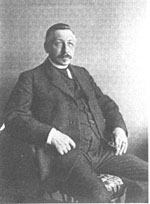
Pieter Jelles Troelstra (1860-1930), lawyer and journalist, SDAP
co-founder and party leader 1894-1925.
Troelstra was educated as a lawyer, among others by future prime minister Cort van der Linden. In his practice he came
to know the misery of the poor, and he became a socialist and a member of the SDB.
Troelstra was convinced that the parliamentary strategy would serve best to help socialism forward, and decided to leave
the SDB when Domela moved towards anarchism. He was canny enough to wait for several lower-class members to become convinced
of the same before taking the step of founding the SDAP. Thus the party did not become an intellectual exercise, but had
a real following among the people, too.
Troelstra was editor of the party newspaper and was elected to parliament in 1897 together with one other SDAP
man. In the next thirty years he would see his party grow tenfold.
During the railroad strike of 1903 against prime minister Kuyper he overestimated the strikers’ position, and his subsequent
chaotic leadership had something to do with the government’s victory.
After being outvoted on government participation in 1913, he was heavily criticised for
agreeing to the war credits in 1914 and suspending serious opposition for the duration of
the First World War.
During the war he mediated between the Allied and Central social-democratic parties to come to
a common socialist peace programme. His failure made him more prone to radicalism, which
led to his famous Mistake.
Still, mainstream left has always been social-democratic and has, until very recently, occupied about two to ten times as
many seats as the social-revolutionaries.
It was the SDAP (Sociaal-democratische Arbeiderspartij; Social-Democratic Workers’ Party) that represented the
socialist denomination in parliament, and it was determined
to play the parliamentary game; that’s the point of getting yourself elected, after all. Still, the socialists
were regarded with fear and loathing, by christians and liberals.
In the Antithesis the socialists were part of the secular block, but it was odd to cooperate with the right-wing
liberals of the BVL, which counted many industrialists among its members. The social-democrats remained chary of
cooperatig with the liberals, beyond voting for laws they thought were in the workers’ interest.
Besides, the SDAP had to keep one eye turned to the left, where the social-revolutionaries were waiting in the wings,
and many socialist voters still had some revolutionary fervour left. The social-democrats played a balancing game.
In 1909 the left wing turned out to be more revolutionary than democratic, and split off to form the CPN, which was
represented in parliament from 1918 to 1986 and is by far the most important social-revolutionary party.
Meanwhile the socialists were building their own denomination, with social clubs, newspapers, sport clubs,
a youth organisation, and of course trade unions. Lots of trade unions. Trade union senior personnel formed
an important recruiting base for the party.
Government
The 1913 elections were a huge success to the SDAP; from 7 they went to 18 seats. The elections were also a success
to the secular block as a whole; the catholic/protestant alliance was soundly defeated.
Still, by themselves the liberals had not enough seats for a majority. They needed the SDAP to create a secular
government. All of a sudden the big choice arrived: should the SDAP participate not only in parliament, but also in government?
In the end, the party council voted No. It decided the time was not ripe yet; the social-revolutionaries would
trounce them come the next elections if the social-democrats were to associate themselves with a capitalist government.
The SDAP supported government’s plans, especially universal suffrage, but did not want to take responsibility for them.
The analysis of the party council may have been correct, but it condemned the SDAP to sit in the opposition for twenty-six
years more. The socialist-liberal coalition idea even had to wait eighty years.
Proportional representation and universal suffrage didn’t bring the socialists as many seats as they’d hoped.
The 1918 elections produced 22 social-democrats and four social-revolutionaries. This was better than the previous 15, but
there was no sign of a breakthrough. The anti-revolutionaries, and especially the catholics, kept their lower classes in
firm check.
Then party leader Troelstra miscalculated that the moment had come for the Netherlands, too, and called
for revolution. He was wrong and lost the prestige he had slowly gathered among non-socialists
permanently, and his party with him. “Troelstra’s Mistake” caused the SDAP
to spend twenty years in the opposition.
Still, the SDAP conquered the large cities. One after the other they got an SDAP-led coalition, and the social-democrats
could show they could take responsibility and cooperate with other parties.
The 1937 party convention decided to move somewhat more to the centre (class struggle was removed as a party goal, for
instance). Besides, the political situation changed with the fall of the ARP, and just
before World War II the first social-democrats entered Dutch government.
The interbellum (1918-1940)
Interbellum politics are characterised by increasing tensions within the victorious
catholics/protestant coalition. Although RKSP, ARP, and CHU remained locked in a nominal alliance
and ruled the country throughout this period, the catholics began to move left and the protestants
a bit to the right. Besides, there was a vicious blast of old-fashioned religious war between
the catholics and the CHU.
The fundamental problem of the era was that there was no easy alternative to the christian
coalition. There
were no other possible combinations of parties that promised a parliamentary majority. The liberals
had too few seats to rule with either catholics or protestants, and even socialists and protestants
together didn’t have a majority.
A coalition between catholics and social-democrats, possibly reinforced by left-liberal
VDB, was the only numerically possible alternative. The catholics staunchly
refused such a coalition for twenty years, afraid as they were of losing their right wing.
Proportional representation
The ten new groups elected in 1918 were:
- Former finance minister Treub (ex-VDB) and two associates.
- Two communists.
- One left-wing anti-revolutionary.
- One christian socialist.
- One social christian.
- One anarcho-liberal socialist.
- One farmer.
- One non-commissioned officer.
- One pub owner.
- One cabaret artist.
Only the communists and the farmer were reelected. Treub, the cabaret artist, and the pub
owner merged into the VB, and the christian socialist defected to the communists.
The left-wing anti-revolutionary, social christian and anarcho-liberal parties merged into other
parties that were represented later.
This is the down side of proportional representation.
We already discussed the changes in the electoral system
between 1918 and 1937, when the current system was adopted. It’s now clear why these changes were necessary.
The 1918 elections were the first to be held under the system of proportional representation.
Instead of the seven parties of 1917 (social-democrats; liberals of
the left, centre, and right; catholics; and ARP and CHU), the 1918 parliament contained no less than
seventeen parties, eight of which held only one seat.
The catholics (24 to 30) and the social-democrats (15 to 22) were the great winners. Under the district system
many northern catholics, who were in the minority in their district,
had been forced to vote for protestants, or had abstained. Now these votes became meaningful.
The social-democrats benefited from a similar effect, as well as from the newly-created voting rights for
the lower classes. Still, four seats’ worth of votes had gone not to the social-democrats,
but to three social-revolutionary parties on the extreme left.
In the protestant camp the ARP and two left-wing protestant parties each won one seat, but CHU lost three, for
a net gain of 0.
The liberals went from 39 to 18 seats. Evidently the old system had protected them.
In reaction, centrist LU (21 to 6 seats), right-wing BVL (10 to 4) and three small parties formed the
VB (Vrijheidsbond; Freedom League). Left-wing VDB remained independent.
RKSP, ARP and CHU together held exactly 50 of the 100 seats. They formed a government,
certain to gather the single vote they needed somewhere, either with the small protestant
parties or the liberals.
Finding a prime minister was a problem, though. Kuyper was too old,
Colijn not yet quite ready for the top spot, and former prime minister Heemskerk refused. When
the ARP had thus exhausted its resources, the RKSP was allowed to nominate Ruys de Beerenbrouck,
who became the country’s first catholic prime minister,
as well as the youngest at the tender age of 45.
Troelstra’s mistake
In November 1918 World War I ended with revolutions throughout the defeated Central powers. The Russian czar had already
been deposed and communists had taken over, and now the emperors of Germany and Austria-Hungary, too, were sent into exile.
In Germany, the social-democrats took power.
The SDAP started to wonder if the revolution had come after all. Party leader Troelstra, pulled leftward by the need
to reconquer the social-revolutionary voters, declared it was time for the workers
to take power, and advised the newly-formed government to resign.
National sentiment immediately rallied around the Queen, who would inevitably be deposed by the new socialist state.
After a huge pro-monarchy manifestation in which catholics, protestants, and liberals all joined
it became clear that many workers didn’t support Troelstra at all, let alone the middle classes.
Troelstra hurriedly declared he’d been misunderstood; and the whole episode became known
as “Troelstra’s mistake.” It made the SDAP look dangerous, and therefore it was to remain in
the opposition for twenty more years.
Condemned to coalition
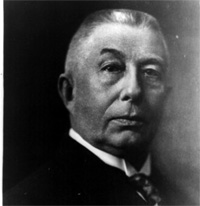
Hendrikus Colijn (1869-1944), war minister 1911-1913, ARP party leader 1920-1944,
finance minister 1922-1925, prime minister 1925-1926 and 1933-1939.
Originally an officer in the Dutch colonial army, Colijn helped with the “pacification” of Atjeh, the
northernmost (and extremely troublesome) part of Sumatra. He enthousiastically participated in
the counter-terror offensive of the early 1900s.
During his military career he always kept an eye open for business opportunities, and he cashed
majorly on the oil found quite near to Atjeh. He became director of the Bataafsche
Petroleummaatschappij, one of the predecessors of Royal Dutch Shell.
Colijn had always been a convinced anti-revolutionary and his freshly gained war laurels made him
a good choice for war minister in the third catholic/protestant government. When
Kuyper died in 1920, Colijn was his natural successor.
Colijn led five governments and was prime minister during most of the crisis of the 1930s, in which
he made himself exceedingly impopular with the lower classes due to his cuts on welfare just when
it was needed most.
In the difficult thirties, with the Great Depression giving rise to unemployment and uncertainty,
Colijn became something of a strong man, aided by the personal support and confidence of the
Queen. Thus extremist voters, who strengthened both communists and national-socialists,
still had an in-system strong man to vote for, too. That may have moderated the political
extremism in the Netherlands a bit.
Nowadays he’s mostly remembered for his 1936 remark that the Dutch “should go to
sleep peacefully” when Hitler re-occupied the Rhineland. The government would take care the
the threatening world storm would pass the Netherlands by.
Of course, Colijn turned out to be totally wrong in 1940, when the Germans occupied the Netherlands.
Initially he bowed his head and proclaimed that the German hegemony in Europe was a fact of life
that the Dutch had to get used to, but he changed his mind a few weeks later.
Partly because of this he was imprisoned for his last years. He was treated quite civilly (he
might serve the occupiers as political small change, after all) and died of natural causes.
The Ruys I government was succesful in so far that it survived.
In 1920 a heated struggle about military spending placed catholics opposite protestants and caused the fall
of government. The Queen refused to accept the resignation, though. The christian coalition
had conquered power in the state, now let them rule it. The catholics, ARP, and CHU were condemned to each other.
The three christian parties won 8 seats in the 1922 elections; mostly because the rules had been changed to
make it harder for very small parties to enter parliament. Therefore
the Ruys II government succeeded the Ruys I government, and it muddled through another parliamentary period, with
another military spending fight, and another temporary resignation.
Towards the end of the parliamentary period, ARP finance minister Colijn more or less took over government leadership
from prime minister Ruys, and he became the symbol of severe spending cuts and hated new taxes (among others on bikes).
Not that he minded; Colijn was always a man of the hard right.
In the 1925 elections catholics, ARP and VB lost seats, with the gains going to SDAP, VDB, as well as some new small parties.
If the elections were a referendum on Colijn, he lost it.
Kersten’s night
Despite this, Colijn was appointed former, and he created a normal coalition government with catholics,
ARP, and CHU, of which he became prime minister. Unfortunately he had made one mistake during government formation:
he hadn’t adequately covered the Dutch embassy at the Holy See.
Political folklore dictated that, every year when the foreign affairs budget was discussed, a
protestant would propose cutting the budget for this embassy. A protestant nation should not communicate
with the Antichrist in Rome, after all.
The CHU would unfailingly support the motion (if it didn’t propose it), the catholics would be duly aghast, and would
combine with the ARP and a few secular parties to defeat the motion. Thus the protestants could make their point without any
real danger to the embassy.
During the 1925 formation, the catholics had indicated that to them the abolition of the embassy would be a reason to
resign from government. Colijn assumed the yearly ritual would be played out and government would return to the order of the day,
and did nothing.
The CHU relented to the point that it let SGP leader Kersten actually propose the cut, and that’s why this episode
is known as “Kersten’s Night.” Nobody was particularly surprised, not even when the CHU indicated its
support.
Then, however, catholic leader Nolens declared that he could not cooperate with parties that supported the closing of the
embassy. This made the secular parties sit up and take notice. The script was being changed; now that the ritual embassy motion had
suddenly acquired so much extra meaning, they eagerly voted for Kersten. The motion passed, and the catholic
ministers resigned from government.
“Direst necessity”
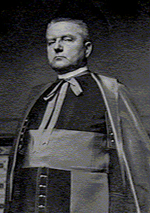
Willem Nolens (1860-1931), priest, RKK/RKSP party leader 1910-1931.
When elected to parliament, Nolens became part of the left wing of the catholics. He had an open eye for the social
issue and helped found the catholic mine workers trade union. He also played a leading role at international catholic
conferences about social issues.
In 1915 he was named Dutch special ambassador at the Holy See, where he was to cooperate with the Pope in trying to end
World War I. Ten years later he would have to defend the existence of this embassy in parliament.
He became leader of the catholics in 1910, and closely worked with all governments from then on. When the 1918
victory came around Nolens refused to become prime minister; the protestants would be aghast at the spectacle of a
priest-prime minister.
Despite his work against the excesses of capitalism, and frequent cooperation with the SDAP on individual laws,
he steadfastly refused to admit the social-democrats into government.
Now the Queen went through a lot of formers.
First VDB leader Marchant tried to create a coalition between his own
left-liberals, the SDAP, and the catholics, but he failed. Nolens declared that the catholics would
cooperate with the social-democrats only in the “direst necessity.” Since the
proposed combination was the only real alternative to the christian coalition, this put everybody
back to square one.
The embassy question remained a hot topic between the catholics and the CHU, and this was the main
reason for the formation of a new government to stretch for months. Finally CHU former De Geer
was more-or-less succesful in forming an extra-parliamentary government.
Now starts an odd period in Dutch politics, where government consisted of members of the three christian
parties, but the parties hadn’t officially agreed to this coalition. Besides, pretty quick it became
clear that the tensions between catholics and CHU hadn’t disappeared.
In practice, the catholics often cooperated with SDAP and VDB, especially on social issues — issues
that became vastly more important with the Great Depression of the thirties. The CHU had always been
right-wing, and as time progressed the ARP, led by Colijn, moved rightward, too.
Nolens’ “direst necessity” blocked the formation of the only possible government
that could get a majority and a formal agreement from the parties in question.
The catholics refused to form the centre-left coalition partly because the bishops had forbidden
cooperation with the social-democrats, partly because Nolens did not want to annoy his right wing.
Thus the christian coalition remained in power, but now the catholics,
then the CHU, found reasons not to come to a formal agreement, although they allowed the
extra-parliamentary government of the day to muddle through.
The Colijn era
In 1933 ARP leader Colijn returned. He proposed the formation of a broader government, where
the two liberal parties would cooperate with the three christian ones — partly because the
serious economic situation demanded a broad government, and partly because this might be a way
out of the political deadlock.
The catholics, however, refused to work with right-liberal VB,
and the CHU refused the four-party coalition that the catholics proposed. Back to square one.
The embassy had not been forgotten.
Thus Colijn formed an extra-parliamentary government with christians and liberals, and
he himself became the undisputed leader of the country. Clearly right-wing, he projected force, confidence, and order.
Still, in 1935 his second government fell after the catholics had again combined with the
SDAP against cuts in welfare. The catholics were ordered to form a new government, but
only the social-democrats wanted to join it. Apparently “direst necessity” hadn’t
come yet, and they returned the formership to to the Queen, who again called on Colijn.
Colijn formed a broad government that distinctly resembled his previous one.
In 1937 the voters rewarded the ARP with three extra seats; nothing less than revolutionary in
pre-war politics. Colijn now felt powerful enough to do away with the liberals, and a
three-party government was formed, which fell after two years due to mutual distrust, as well as
the catholics’ opposition against Colijn’s hard-right financial policies.
Colijn, now over-confident by his personal popularity and the Queen’s support,
formed a fifth government that consisted only of protestant and right-liberal VB ministers, but the
very first time it appeared in parliament it was voted down by catholics, VDB, and SDAP.
Thus ended Colijn’s political career.
Now that the centre-left parties had cooperated for the umpteenth time, and the ARP
had totally fallen from political grace, the catholics finally admitted that
“direst necessity” had come. When CHU leader De Geer was appointed former,
the catholics readily agreed to participate together with the social-democrats.
Thus the SDAP finally entered the halls of power, and the ARP was excluded. Unfortunately,
scant months later the Germans invaded the country and the new, broad government had to
flee to London along with the Queen.
World War II (1940-1945)
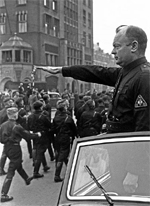
Anton Mussert (1894-1946), NSB party Leader 1931-1945. Originally a waterstate engineer, Mussert
became nationally known during a campaign against a treaty with Belgium that would require the Dutch
to allow a canal between Antwerp and the sea; something that would threaten Rotterdam’s position
as a port.
After the war Mussert was one of a select few high-level Dutch traitors who were executed.
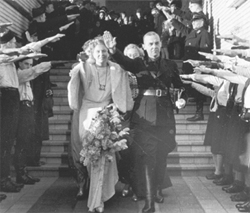
Meinoud (1894-1945) and Florrie (1914-2007) Rost van Tonningen in happier days during their 1940 SS marriage.
Meinoud Rost van Tonningen was born in a well respected family; his father had been a colonial general,
while his brother held a high function at royal court.
In 1936 he was in Vienna working for the League of Nations when Hitler annexed Austria. Thus Rost
became interested in national-socialism, and he was granted an audience with the
Führer himself. That made Rost a nazi, with all the zeal of the recent convert.
Rost became the leader of the radical wing in the NSB, which was firmly German-orientated and advocated
a firm stance against the Jews, a “problem” that didn’t interest Mussert much.
When Mussert refused his seat after the disappointing 1937 elections Rost became the NSB parliamentary
leader.
After the German occupation Rost
started to intrigue against Mussert, aided by his excellent SS connections all the way up to Himmler and
Hitler, who found Rost’s nominal Leader insufferably bourgeois.
Rost became director of the national bank, enthousiastically squandering the Dutch treasury in support
of the war effort.
After the war, sure to be executed, he committed suicide in prison. His wife Florrie maintained he was
murdered because he knew too much.
Florrie Rost van Tonningen, born in a respectable banking family, survived her husband for sixty years and remained
a convinced national-socialist for every
one of them. From the early seventies on she organised meetings with kindred souls,
presumably teaching the finer points of nazi ideology and sharing her fond memories of the Führer,
the Reichsführer SS, and other luminaries of the Third Reich.
She remained in touch with the Hesses and the Himmlers, dabbled in Europe-wide neo-nazi politics,
more-or-less endorsed the NVU, and gained notoriety as the “Black Widow.”
She was supported by a state pension because her husband had been a member of parliament. When that
was discovered in 1986 some parties tried to stop the pension, but that attempt failed. A 2000
appearance on national television showed she was still quite able to defend herself, although she
conceded Hitler had made “mistakes” with regard to the Jewish question.
On 10 May 1940 the German army invaded the Netherlands. The attack was swift and with
overwhelming power, although the Dutch army defended itself bravely. However, the German
high command immediately landed paratroopers in the west of the country, and when after
four days the Dutch army still hadn’t capitulated, it bombarded Rotterdam to rubble,
and said that Amsterdam was next on the list. Meanwhile government and royal family had
fled to London, and the Dutch army capitulated. Thus started five years of occupation.
Occupation
The Germans were welcomed by the small national-socialist part of Dutch society, and although
the vast majority of the population was not very happy with the situation there was almost no
open hostility.
The Dutch hadn’t had any experience of war since the
French retreated from the country in 1813, and besides they trusted the Germans would be civilized
about the whole situation. They were completely unprepared for what was to follow.
At first the occupiers were surprisingly mild; back in the early days Hitler still had hopes that
the Dutch (who were, after all, of Germanic descent and thus part of the Herrenvolk) would
see the blessings of national-socialism by themselves. In addition, a calm build-up of the persecution
of Jews and other undesired elements had the advantage of lulling Dutch authorities to sleep and
obtaining their more-or-less voluntary cooperation by small steps.
NSB
In 1931 the NSB (Nationaal-Socialistische Beweging; National Socialist Movement)
was founded to spread national-socialism in the Netherlands. Although there
were countless fascist and national-socialist parties, party Leader Mussert was politically rather colourless and
allowed anyone to project whatever they wanted on him. Besides, the NSB carefully prepared its contacts with
the media, and it grew fast. In 1935 it won 8% of the vote in the provincial elections; the
4% for the 1937 parliament elections were distinctly disappointing.
The NSB enthousiastically applauded the 1940 German invasion, and Mussert considered the NSB (and its Leader)
a vital ingredient of the ideological alignment of the Dutch people and their fellow Aryans. The Germans disagreed; they
never trusted Mussert enough to give him real power. In 1942 Mussert was made
Leader of the Dutch, but that remained an empty title.
When political parties were disbanded, an exception was made for the NSB, even though
high-ranking nazis didn’t think much of the party leaders and never gave them any real power.
Besides, the nazi/fascist wing of Dutch politics was riddled with strife and friction,
and although the NSB was the only openly nazi party ever represented in parliament, at least
three other groups clamoured for the occupiers’ attention. Finally, there was a
rift within the NSB itself (see sidebar).
In the end the NSB help didn’t mean that much to the nazis. It made other Dutch
exceedingly angry, though, and especially during the last years of the war several high-ranking
NSB members were shot by the resistance.
Persecution
More-than-incidental resistance to the occupiers started only in 1943, when Stalingrad
had shown the balance of the war had shifted to the Allied. The communists and anti-revolutionaries,
especially, distinguished themselves in the resistance, as well in the hiding away of persecuted
people.
From 1942 onward the German Arbeitseinsatz began to round up Dutch men for thinly-veiled
slavery in the German war industry. This gave an extra boost to the resistance, but also meant that many
more people had to be hidden inside the country.
Nonetheless, the resistance failed badly when it came to Jews. In the five years of occupation the
nazis managed to deport and murder about 100,000 Dutch Jews (including Anne Frank).
Later on this percentage turned out to be the highest in all nazi-occupied Europe.
The occupiers were helped by the fact the Dutch civil service kept meticulous population records
which included the religion of each person (it was important to know the catholic vs. protestant
ratio in denominationally segregated Dutch society, after all). Besides, Dutch police officers, railroad
workers and others continued to do their duty, even if that involved rounding up Jews and transporting
them.
Liberation
After the landing in Normandy in 1944, people understood the Third Reich was finished. When the
Alied started a quick march north and east, and in September 1944 panic broke out under
the pro-nazi Dutch, when one after the other France, Belgium, and the southern provinces
were liberated.
However, the Allied march stopped at the great rivers after the attempt to conquer the
Arnhem bridge proved A Bridge Too Far. The northern part of the country
had nine more months to go; far and away the worst of the war.
Not only was persecution stepped
up, the Germans also started to demolish stuff at random. Combined with the incessant Allied
bombardments of the railroads, this basically closed off the western provinces and led to
the winter of hunger, when food was so scarce that people ate tulip bulbs and anything
else that came to hand. (My mother still remembers the taste, and she still hates it.)
In the end the Netherlands were liberated only in May 1945, after Hitler’s death and
scant days before the Third Reich capitulated.
The northern Netherlands, that is. The south, the catholic south, had
plenty of time to restart politics as usual without being bothered by the liberals, the protestants,
or the socialists. Especially the socialists. Party leadership could make sure that the catholic
flock was united and the left-wingers would not vote socialist in the first post-war elections.
Continue
The problem of the catholic left wing forms the core of politics in the the fifties and sixties.
What was it going to be, Roman or red?






